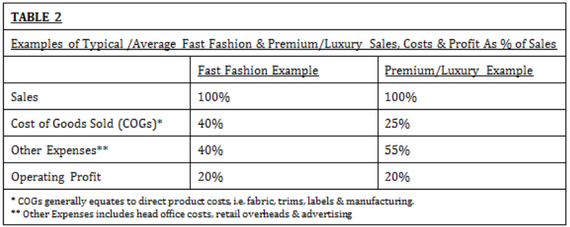
Are you really getting what you pay for?
My previous post discussed low-cost garment manufacturing in the fast fashion segment. But shockingly, a number of premium and luxury brands also opt for these suppliers, leaving you footing the bill for advertising costs, not quality and ethical clothing.
Both the fast fashion and premium/luxury companies that use low cost manufacturing are earning healthy profit margins of around 20%.
In Table 2 below is a breakdown of typical cost structures for selected high street and premium/luxury brands.
The two main cost components are COGs (i.e. product costs including fabric and other garment components plus manufacturing) and Other Expenses (which generally constitute head office and administrative costs, retail overheads and advertising).

With fast fashion brands, most customers assume their cheap clothes are a direct reflection of low-cost manufacturing. This is correct in some respects. As highlighted in the table, around 40% of a garment's price is allocated to its production.
However a further 40% is allocated to other expenses which mostly reflects retail overheads and advertising. So a customer is paying probably as much for the brand's shops and promotion imagery as for the product itself. As we have seen, fast fashion retail outlets can now be found on the high streets and in the malls of towns and cities across the world. Much of this growth is being financed by low cost manufacturing.
What is of greater interest is the cost breakdown for premium and luxury brands that also use low-cost suppliers. Again profit margins here are robust at around 20%.
In this instance, however, only around 25% of a garment's price is allocated to the cost to make it. It would seem that as much as twice that cost or more is allocated to its sale which is mostly advertising given these brands tend to have relatively fewer retail outlets when compared with their high street peers.
So, in reality, the price of premium/luxury garments made in low-cost regions bear little relation to the cost to make them. This is underlined by data in Table 1.
For example, a jacket made in Madagascar that took, say three hours to make, would imply a labour cost of US$0.75 and a manufacturing cost of around US$2.50 (on the basis that labour costs account for around 30% of a factory's costs which is typical). The respective cost in Vietnam would be around US$5. This compares with a price tag that could easily exceed US$1000.
This would, no doubt, surprise many premium/luxury customers particularly those who believe that what they have been paying for is a product of superior quality in all respects and one that has been manufactured in one of the traditional heritage markets, e.g. Italy or the UK.
Aside from the quality there is an element of the cost for premium/luxury products that is attributed to the 'brand'. What customers perhaps don't realise is that most of what they are paying for in reality is advertising, i.e. A-list celebrities in multi-million dollar promotion campaigns.
Customers would need to decide whether these very high advertising costs are genuinely worth the price tag.
What we would encourage customers to do is to look at the label of every item they buy and to assess for themselves whether:
1) they are actually getting what they're paying for?
2) the manufacturing country has pay and working standards they find acceptable?
For reference we include in Table 3 a list of familiar manufacturing countries along with wage rates and human rights rankings.

For companies, decisions about where they manufacture will have to be weighed against potential reputational damage. This could result either from being associated with developing world factories where under-investment in working conditions leads to another Rana Plaza-type disaster. It could also result from customer protest especially for those who want their premium/luxury product to be made in a market that is actually associated with luxury.
Some companies, particularly the global fast fashion brands, would argue that only developing markets have factories large enough to undertake the immense volumes they need. However, that would not be the case for most brands, particularly luxury names which produce in much smaller volumes.
Some companies may also argue that they undertake overseas production in order to naturally hedge foreign exchange risk. This would only be viable for markets in which they sell as well as produce. The point to note here is that the Chinese are renowned for eschewing Chinese-made products. As for other developing world markets, customers there would be few. The developed world represents the majority of customers.
I would also argue that if these brands really did care about pay and working conditions then they could start by paying their interns. As the saying goes - charity begins at home.
For my company I have to consider whether our unwavering ethics will leave us, not only in the wilderness, but uncompetitive.
If my peers have the material advantages of cheap manufacturing and free interns - neither of which I choose - I could also find myself between a rock and a hard place...